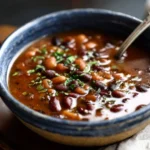Coconut Pineapple Upside-Down Cake: A Tropical Treat
Introduction
Coconut Pineapple Upside-Down Cake is a beloved dessert that brings a taste of the tropics to your table. With its golden caramelized top, soft cake base, and the perfect blend of coconut and pineapple flavors, it’s a showstopper for any occasion. Whether you’re baking for a summer picnic, a family dinner, or just because you’re craving something sweet and fruity, this cake never disappoints. It’s a modern twist on the classic upside-down cake, which traditionally used apples or cherries. Now, with the addition of tropical flavors, it brings a refreshing change to the dessert table.
The History
Upside-down cakes have a long history, dating back to the 19th century in the United States. Originally made with apples or cherries, they became more popular with the advent of canned pineapple in the early 20th century. The pineapple version, especially, became a favorite during the mid-century tiki craze, where tropical flavors were all the rage. Coconut was later added to complement the pineapple, creating the Coconut Pineapple Upside-Down Cake we know and love today. This version is particularly popular in Hawaii and other tropical regions, where both ingredients are abundant.
Ingredients Breakdown
Each ingredient in this cake plays a crucial role in creating the perfect texture and flavor:
- Butter: Adds richness and helps create the golden caramelized topping.
- Brown sugar: Combines with the butter to form a sticky, sweet caramel layer.
- Pineapple slices: The star of the topping, they add juiciness and natural sweetness.
- Maraschino cherries: A classic addition for a pop of color and tart flavor (optional).
- Flour: Provides structure to the cake.
- Sugar: Sweetens the batter and balances the tartness of the pineapple.
- Baking powder: Ensures the cake rises properly.
- Coconut flakes: Adds texture and a tropical flavor to both the topping and the cake.
- Milk: Keeps the batter moist and smooth.
- Eggs: Bind the ingredients together and help with leavening.
Step-by-Step Recipe
Prep Time:
15 minutes
Cook Time:
35–40 minutes
Total Time:
50–55 minutes
Servings:
8–10 slices
Ingredients
- 1/2 cup (1 stick) unsalted butter
- 3/4 cup packed brown sugar
- 1 (20 oz) can pineapple slices, drained
- 8–10 maraschino cherries (optional)
- 1 1/2 cups all-purpose flour
- 1 1/2 teaspoons baking powder
- 1/2 teaspoon salt
- 1/2 cup unsalted butter, softened
- 1 cup granulated sugar
- 2 large eggs
- 1 teaspoon vanilla extract
- 1/2 cup milk
- 1/2 cup sweetened shredded coconut
Directions
- Preheat oven to 350°F (175°C). Grease a 10-inch cast iron skillet or round cake pan with butter.
- In the pan, melt the butter over medium heat. Once melted, stir in the brown sugar and cook for 2 minutes until it starts to bubble and thicken.
- Remove from heat and arrange pineapple slices on top of the caramel mixture. Place a cherry in the center of each pineapple slice, if using.
- Evenly sprinkle the shredded coconut over the pineapple and cherries.
- In a large bowl, cream together the softened butter and granulated sugar until light and fluffy.
- Beat in the eggs, one at a time, then stir in the vanilla extract.
- In a separate bowl, whisk together the flour, baking powder, and salt.
- Add the dry ingredients to the wet ingredients in three parts, alternating with the milk, beginning and ending with the dry mixture. Mix until just combined.
- Spoon the batter over the fruit layer in the pan, spreading evenly.
- Bake for 35–40 minutes or until a toothpick inserted into the center comes out clean.
- Let the cake cool in the pan for 10 minutes, then carefully invert onto a serving plate.
- Serve warm, optionally with a scoop of vanilla ice cream or whipped cream.
Tips
- Use a cast iron skillet for even heat distribution and a crisp caramelized top.
- Let the cake cool slightly before inverting to avoid burning from the hot caramel.
- If you don’t have a cast iron skillet, use a heatproof glass or ceramic dish that’s oven-safe.
- To ensure the cake releases easily, run a knife around the edges before flipping.
- For extra coconut flavor, use coconut milk instead of regular milk in the batter.
Variations and Customizations
- Gluten-Free: Substitute all-purpose flour with a 1:1 gluten-free baking flour blend.
- Dairy-Free: Use vegan butter and almond or oat milk to make it dairy-free.
- Coconut Lovers: Add more coconut to the topping and mix some into the batter.
- Tropical Twist: Add diced mango or kiwi along with the pineapple for a fruit medley.
- Spiced Version: Add a pinch of ground cinnamon or nutmeg to the batter for a warm flavor twist.
- Almond Coconut Cake: Add a few drops of almond extract and top with sliced almonds.
Health Considerations and Nutritional Value
While Coconut Pineapple Upside-Down Cake is undeniably delicious, it is a dessert best enjoyed in moderation. Here’s a general nutritional breakdown per serving (based on 10 servings):
- Calories: ~300–350
- Fat: ~12–15g (mostly from butter and coconut)
- Carbohydrates: ~50–55g (from sugars and flour)
- Protein: ~4–5g (from eggs and milk)
- Fiber: ~1–2g (from coconut and pineapple)
It contains natural sugars from the pineapple and some fiber from the coconut, but also a significant amount of added sugar and saturated fat. To make it healthier:
- Use whole wheat flour or almond flour for added fiber.
- Replace some of the sugar with coconut sugar or a natural sweetener like maple syrup.
- Use low-fat milk and reduced-fat butter.
- Opt for unsweetened dried pineapple or fresh pineapple to reduce added sugars.
FAQ
Can I use fresh pineapple instead of canned?
Yes! Use fresh pineapple slices and lightly caramelize them in the pan for a more intense flavor.
Can I make this cake ahead of time?
Absolutely. Bake and cool the cake completely, then store it in an airtight container at room temperature for up to 2 days or refrigerate for up to 4 days. Reheat gently before serving.
Can I freeze the cake?
Yes. Wrap it tightly in plastic wrap and aluminum foil before freezing. Thaw at room temperature and reheat in the oven for best results.
What if my cake sticks to the pan?
Make sure the pan is









